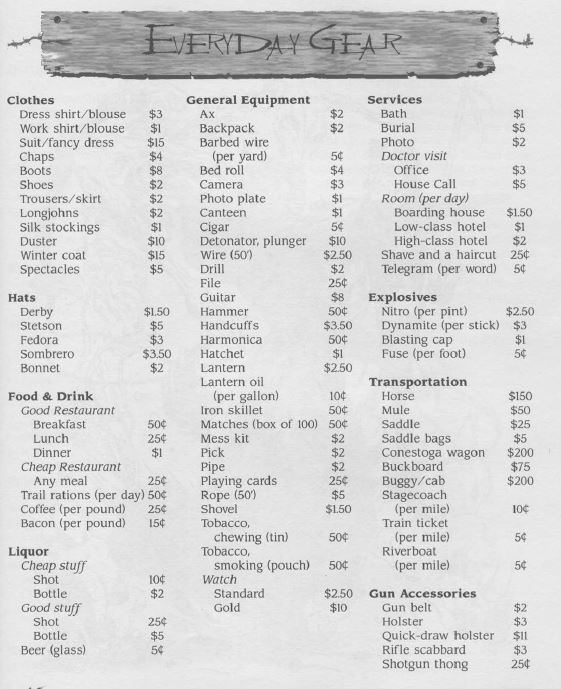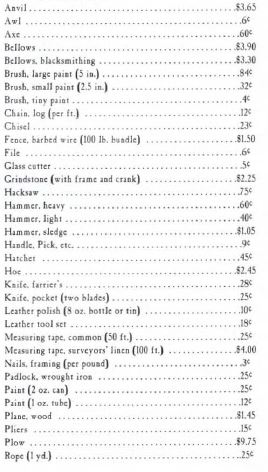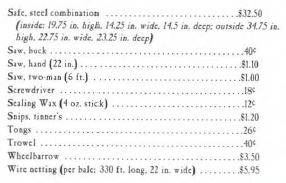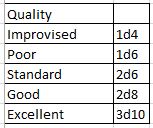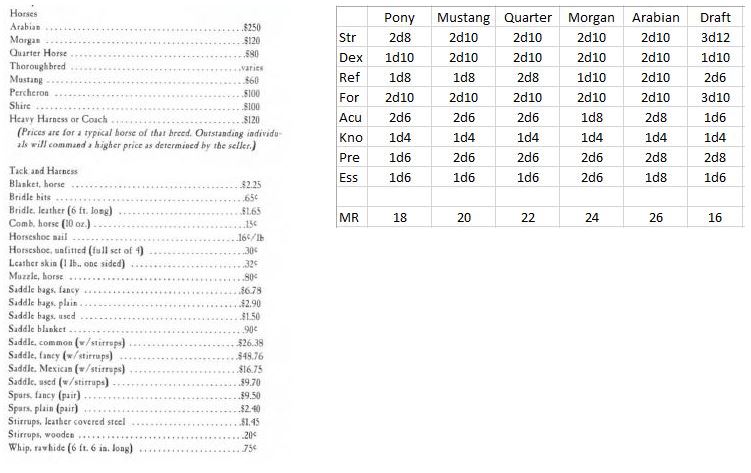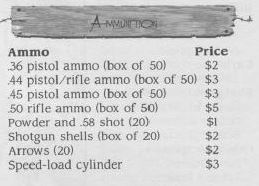The West That Wasnt - Gear
The following items are available in the West That Wasnt. These lists are not meant to be exhaustive, and have obviously been stolen from other sources just so we can get the playtesting underway. When this gets into a final state a new gear section will be created.
Using Gear
In most cases, to use an item it must be ready. Items are readied by performing an action. Readying an item might include taking a hammer from a toolbox, drawing a sidearm or even un-tethring a horse. Readying the item does not include any movement it takes to get to the item, but it does include any assembly if the item is normally stowed or carried unassembled. In most cases, readying an item is a Normal speed action.
Type Attributes
All items have an attribute that is related to the type of thing it is, such as a hammer is a tool, and therefore it has the tool attribute. These attributes are not all listed on the gear tables. Usually it is clear if a type attribute applies to a given item, but when it is not, the Judge has the final say.
Everyday Gear
Tools
Tool Quality
Equipment is rated in quality from improvised to excellent. Improvised gear is equipment that has been made haphazardly or is being used in a way that it is not intended. For example, a rock or a stick may be used as a shovel, or even a hammer. They will work in a pinch, but are not good at the job. Poor quality tools are either old and worn out, or just shoddily made. The majority of tools are standard quality. Some items are of good quality, in general these cost 2-4x the listed price and are not available everywhere. The best items available are excellent quality, those produced by the finest craftsmen. They cost 10x the listed price.
Not all tools have the higher quality versions available. The simplest tools, such as hammers and shovels, can only be so good. Even the best versions do not produce better results, but instead are sturdier and last longer. Consult the Judge on whether a particular tool has higher quality options, and if they do, whether those items offer the increased efficacy, or only greater durability.
Mounts
Weapon Accessories
A speed load cylinder holds six rounds and can load all six in a single, Fast action. Reloading the cylinder is a Fast action for each round (as a normal reload).
Hand Weapons
Impact: Impact attacks deal only concussion. Their damage is added directly to the Strength damage of the character.
Deadly: Deadly weapons deal wounds as well as any other effects. When using Non-Impact attacks with a deadly weapon, characters with d10 Strength receive one conditional "damage only" bump versus unarmored foes, d12 Strength characters receive 2. This may not more than double the effect row.
Slash: Slash attacks are deadly. May be used with the Defense attribute.
Pierce: Piercing attacks are deadly. Characters with d10 Strength receive one conditional "penetration only" bump, d12 Strength characters receive 2. When combined with the result on the action card, the value cannot exceed +2. This attribute only works with Strength based attack types. Pierce cannot be combined with Defense.
Throw: Weapon can be thrown. See muscle powered section under ranged weapons for statistics.
Defense: The number in parentheses is the number in parentheses is the number of advantage factors gained by the weapon when defending.
Pain: Concussion damage is doubled when determining result from Stun Save.
Short: Weapons with the short attribute reduce the TN for the Draw 0 result by 1 in any fast draw attempt. All Short items are also Fast.
Fast: Weapons with the Fast attribute can be readied with a Fast action.
Fistload: Character counts as armed versus armed foes or others using fistloads, unarmed versus others. Weapon deals Strength damage as well as weapon damage.
If a weapon has multiple attributes, the player may choose which to use during each action, at Judge discretion. Slash, pierce and impact are mutually exclusive. Thrown weapons may only use attributes listed on the muscle powered weapons table, below.
Ranged Weapons
All ranged weapons have an Aim value, which is speed of the aim action, followed by a slash with a penalty listed for snap fire. The SPD value is the speed of the weapon (when cocked or ready, as applicable) followed by the speed of any cock action. Cock actions ready one barrel, if more than one barrel exists, additional cock actions or speed loading is required.
Ranged Weapon Attributes
Ranged weapons come in numerous sizes and shapes, often with differing performance based on the attributes of the weapon. What follows are three types of attributes: shot, action and other. Shot attributes discuss how projectiles are delivered, propelled and contained. Action describes how the weapon is operated mechanically. Other attributes discuss anything else about the weapon that is noteworthy in game play.
Shot Attributes
Cartridge: Cartridges are self contained bullet and powder in a single unit. Loading most cartridge weapons is a Fast action and speed loading is possible. Single action pistols are a Normal action to reload unless they have the Top Break attribute. Some cartridge rifles also have longer reload speeds, and are notated in the attributes.
Muzzle Loader: Muzzle loading weapons require loose powder, ball and percussion cap. Muzzle loading a shotgun is a Slow action. If the weapon has multiple barrels, an attempt may be made to load both simultaneously. This requires a Dexterity check at TN 7. Success indicates both are loaded, failure indicates neither are loaded, but both will be successfully loaded next round with no check required. On a CF result, neither barrel is loaded and at least one required item is lost (one shot is spent). Performing a muzzle load on a rifle or musket requires 2 Slow actions to complete. Muzzle loading weapons require a fast action to cock, which can be performed simultaneously with the loading if desired. Muzzle loading weapons cannot be speed loaded.
Percussion: Cap and ball revolvers require a percussion cap, loose black powder and a lead bullet (ball) to load. Loading a Percussion handgun requires a Slow action. One cylinder can be loaded on a 3 TN Dexterity check, two cylinders on a 7. The chamber fails to load on a failure, but can be attempted again next round with no penalty. On a CF result, the chamber is not loaded and at least one required item is lost (the round is spent).
Action Attributes
Breech Load: Breech loading rifles and shotguns are Normal actions to fire when cocked, but require a Fast action to cock. Breech loading rifles can load a single cartridge with a Normal action, and can be speed loaded. Breech loading shotguns can load a single cartridge with a Normal action, and can be speed loaded.
Double Action: Double action revolvers are Normal speed actions and do not need to be cocked to fire. A fast action may be used to cock a double action revolver, and in this case, it acts like a single action for the first shot.
Hammerless: Hammerless shotguns to not need to be cocked to fire.
Lever Action: Lever action rifles are Normal actions to fire when cocked. They require a Normal speed action to cock. Lever action rifles require a Normal speed action to load the first round, but can load subsequent cartridges as a Fast action thereafter. All but the first cartridge can be speed loaded.
Single Action: Single action revolvers are Fast when cocked, but require a normal speed action to cock. Single action pistols are a Normal action to reload unless they have the Top Break or Percussion attribute.
Top Break: Top Break revolvers have a release latch that allows the barrel to draw down and eject spent cartridges, speeding reload time immensely. Top Break revolvers are Fast actions to reload, and can be speed loaded.
Trapdoor: Trapdoor rifles are similar to breech loading rifles, but instead of pushing the cartridge into the barrel from behind, it is dropped into the action from above. The trapdoor can be opened and reloaded as a Normal speed action, and cannot be speed loaded. They require a Normal action to cock.
Other Attributes
2x: Weapons with the 2x attribute may fire both barrels simultaneously. When firing both barrels, add the RD to the DMG on P results, and double the RD on A results.
Accurate: Accurate weapons receive the number in parentheses as a bonus to their shooting result if the shot follows an Aim action.
Fan Fire: A single action revolver is capable of fan firing. When using the fan fire action, the speed is fast, and the burst rules may be used (see Fan Firing skill).
Fast: Ranged Weapons with the Fast attribute can be readied with a Fast action.
Fistload: The character counts as armed versus unarmed characters or other characters using Fistloads. Otherwise, the character is unarmed.
Long: Long weapons increase the TN of the Draw 0 result of any fast draw attempt by the rating in parentheses.
Muscle: Weapons with the muscle attribute are Normal speed actions when ready/loaded, and load/ready as a normal action. If the character has greater than d6 Strength, on a hit result he automatically gains one conditional bump for each die type over d6. These conditional bumps may be used for penetration or damage only.
Quick: Weapons with the quick attribute may reload/ready as a Fast action with a successful Speed Load check.
Scatter: Weapons with the scatter attribute always produce stray shots (see unintended targets, conflict section). Add one to the number of stray shots per range increment. Also, decrement the die type and penetration every two range increments. If a target is hit because of this rule, treat P results as A, and A results as D. Unarmored targets are treated as an A result.
Short: Weapons with the short attribute reduce the TN for the Draw 0 result by 1 in any fast draw attempt.
Optional Rule: Movement During Slow Reloads
Some weapons, especially muzzle loaders but also other weapons which require a series of precise and specific actions, are slow to reload. The rules forbid combining any other action with a slow action. It can be argued that, especially in the case of a muzzle loading derringer, movement would be possible while performing the reload. This is true. Movement is probably technically possible even while loading a muzzle loading rifle, however this makes the action itself significantly harder and likely longer lasting. The goal of the rule in place is "tactical verisimilitude", as discussed in The West That Wasnt - Initiative And Action Speeds. Restricting movement while performing these complicated reload actions is the simplest, and most consistent, way to deliver the desired combat "feel".
If you would prefer to allow movement while performing slow reload actions, the following system is suggested. Any time a slow reload action is combined with movement, the action becomes TN 5. Failure means the action is still in progress at the end of the round and must be attempted again. A critical failure means the round is expended and the reload must be restarted. This can be because one or more items is dropped, the powder spills, or some other major disruption in the process.
Handguns
All handguns have the Fast attribute.
Single versus double action
In the old west, single action revolvers ruled the day. Single action was first on the market, and even after the more effective double action became available in the late 1870s, most still preferred the single.
Why use a single action? The swifter trigger pull made the first, critical, shot faster by just enough to spell the end of many and unfortunate victim. Single action revolvers were also durable, and simpler to manufacture. And for those who lean toward the ostentatious, only single action revolvers can fan-fire.
They had their drawbacks, as well. Single action revolvers are slower to load. Second, and subsequent, shots were slower (because they had to be manually cocked).
It is possible to cock a double action revolver, and this allows that first shot to be as fast as a single action. It is dangerous to carry a cocked revolver (no matter what the action). Optional rules are suggested below to simulate this. Given all of the advantages, it would seem that the double action revolver is just plain better (hence why modern revolvers are almost invariably double action).
In the end, many if not most of the most successful and famous practitioners used the single action revolver, especially the Colt Single Action Army (AKA the Peacemaker). The double action revolver offered some valuable advantages, but these advantages could not overcome the fame and cachet of the single action.
Colt Lightning
The 1877 Colt Lightning was the first double action Colt revolver. Like other double action revolvers, it can be cocked first and used like a single action. However, unlike later double action revolvers, it has the same loading mechanism of the single action army (the Peacemaker). It acts as a single action for reload purposes. The larger caliber version, the .41 listed here, is usually called the "Thunderer".
Rifles
Shotguns
All shotguns have the Long (1) attribute. They can be "sawed off" to either a normal length (no attribute) or Short. Reduce the range by 3 for each level of sawed off.
